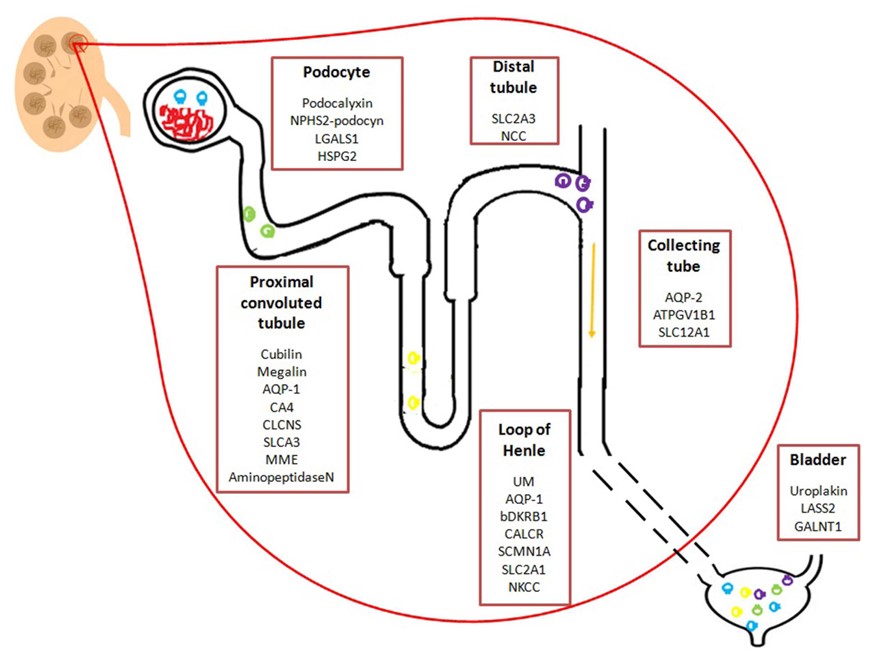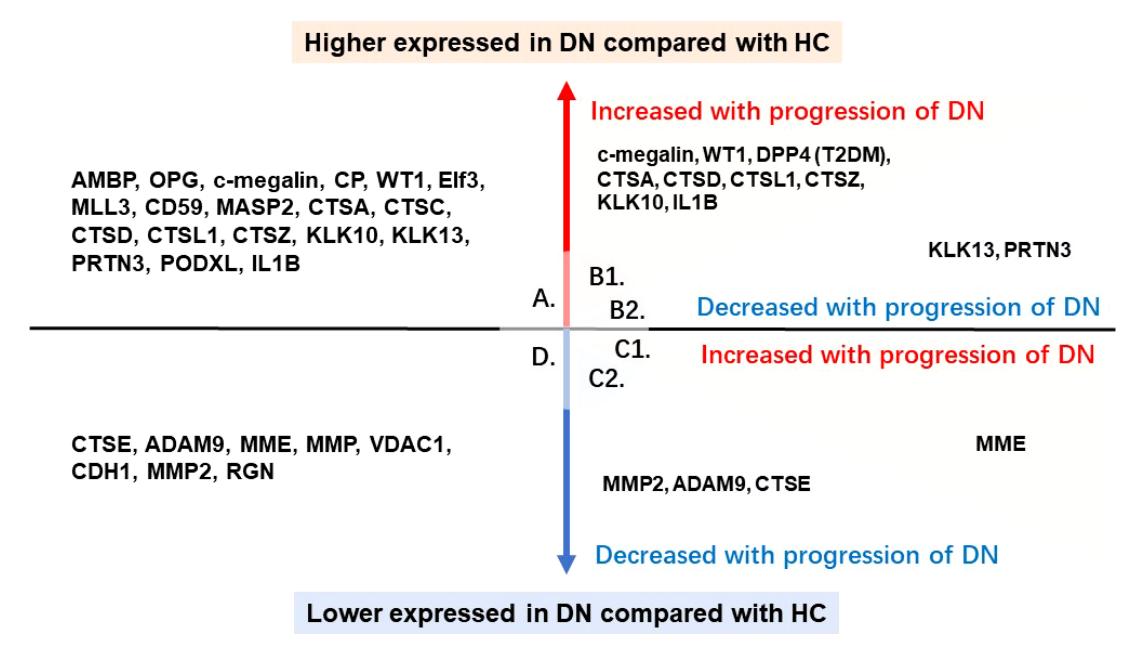Renal Disease Diagnosis-Applied Exosomes
Overview Services Features FAQs
Urinary exosomes and their components as liquid biopsy markers can accurately reflect the physiological and pathological state of the kidney, making it possible to diagnose kidney disease and assess the progression of lesions with non-invasive tests. Creative Biolabs has built a comprehensive exosome research platform, including extraction, purification, and profiling of exosomes, providing research services related to the application of exosomes in the diagnosis of renal diseases.
Application of Urinary Exosomes in the Diagnosis of Renal Diseases Possible
A renal biopsy is necessary to determine the type and extent of kidney disease pathology and is sometimes repeated as needed. It is an invasive test and is often associated with complications such as hematuria, perirenal hematoma, and infection, and some patients miss the best opportunity for definitive diagnosis and delay treatment because of contraindications or refusal of invasive procedures. In addition, elevated proteinuria and creatinine levels do not reflect kidney damage promptly, so it is especially important to find early diagnostic markers for glomerular diseases.
The discovery and continuous research of exosomes have made it possible to diagnose renal diseases non-invasively. It has been found that urinary exosomes are mainly derived from various cells facing the tubular lumen in a physiological state, and the proteins and miRNAs contained in urinary exosomes are involved in the exchange of information between cells in the urinary microenvironment, which are closely related to the occurrence and development of renal diseases.
Urine can be collected non-invasively, and exosomal markers can be detected in as little as 0.5 ml of urine, allowing repeat sampling. More importantly, urinary exosomal proteins can more accurately reflect changes in renal tissues than proteins in whole urine, making urinary exosomes an ideal source of biomarkers for renal disease.
 Fig. 1 Schematic representation of potential urinary EVs biomarkers from the urinary tract.1, 3
Fig. 1 Schematic representation of potential urinary EVs biomarkers from the urinary tract.1, 3
Study of Urinary Exosomes and Their Components for the Diagnosis of Renal Diseases in Creative Biolabs
-
Urinary Exosomal Protein as a Diagnostic Biomarker for Renal Disease
-
Urinary exosomes carrying marker proteins of maternal cell origin were detected by proteomic analysis of exosomes, such as WT1 (nephroblastoma protein-1), NHE3 (sodium-hydrogen exchanger-3 of the proximal tubule), sodium-glucose co-transporter-1/2, AQP-1 (water channel protein-1), NKCC2 (sodium/potassium cotransporter-2 of the ascending thick segment of the medullary collaterals), and NCC (sodium/chloride cotransporter of the distal tubule), etc.
-
NHE3 is the main sodium channel in the proximal tubule and plays an important role in sodium reabsorption and hydrogen ion secretion. Its abundance correlates significantly with tubular injury and can be used to identify tubular necrosis, pre-renal azotemia, and other causes of renal failure, with better specificity than sodium filtration fraction and urinary retinol-binding protein.
-
Abnormal elevations of fetuin-A, a multifunctional protein synthesized by the liver that regulates inflammation and inhibits vascular calcification, are found in urinary exosomes from animal models of kidney injury, while AQP-1 levels are significantly decreased.
-
Urinary exosomal proteinuria α1 microglobulin and WT1 significantly upregulated and MUP1 (major urinary protein 1) and Regucalcin significantly decreased in diabetic nephropathy-derived urinary exosomes, which are expected to be non-invasive early diagnostic biomarkers of diabetic nephropathy.
-
Urinary exosomal NGAL (neutrophil gelatinase-associated lipid transport protein) is associated with renal function after renal transplantation and can be used as an indicator of renal transplantation prognosis.
 Fig.2 Proteins of urinary EV with significant difference.2, 3
Fig.2 Proteins of urinary EV with significant difference.2, 3
-
Urinary Exosomal miRNA as a Diagnostic Biomarker for Renal Disease
In addition to exosomal proteins, miRNAs exist in a very stable form in urinary exosomes and play an important role in the pathogenesis of kidney disease, and their relevance to specific kidney diseases can be assessed using well-established miRNA sequencing.
-
miRNA analysis of urinary exosomes from patients with diabetes mellitus combined with early diabetic nephropathy showed that 22 microRNAs differed in expression in the microalbumin group compared to the no-albuminuria group, with miR-130a, miR-145 significantly upregulated and miR-155 and miR-424 significantly decreased. Urinary exosomal miR-145 was also significantly increased in animal models of diabetic nephropathy, and high glucose treatment of thylakoid cells promoted the release of exosomes containing miR-145. These experiments suggest that urinary exosomal miR-145 may be a marker of early urine in diabetic nephropathy.
-
Analysis of the phenotypic changes of exosomal miRNAs isolated from urine in chronic kidney disease showed that miR-16, miR-92a, miR-21, and miR-124a were abundantly expressed, whereas miR-29 and miR-200 levels were significantly reduced, which was induced by direct regulation of multiple collagen and other extracellular matrix components by the TGF-β/Smad3 signaling pathway.
-
Urinary exosomal miRNAs likewise have prognostic value in assessing the initial stages of graft injury, and their miR-210 has been identified as a reliable marker for the diagnosis of acute rejection in renal transplantation and a predictor of long-term graft function.
Features
-
Non-Invasive Sampling: Exosomes can be isolated from urine or blood, providing a non-invasive method for renal disease diagnosis.
-
High Specificity and Sensitivity: Exosomes contain biomolecules that are specific to kidney cells, improving the accuracy of detecting renal conditions.
-
Early Detection: Compared to conventional procedures, kidney illnesses can be identified early by studying exosomal biomarkers.
-
Comprehensive Profiling: Exosomes carry a variety of biomolecules, including proteins, lipids, and RNAs, allowing for a broad-spectrum analysis of renal health.
-
Real-Time Monitoring: Real-time monitoring of the course of a disease and its response to treatment is possible with exosomal biomarkers.
The analysis of urinary exosomes and their fractions can identify the type of kidney disease pathology, identify acute or chronic kidney lesions, facilitate early detection and intervention of kidney disease, as well as prevent or delay disease progression to end-stage. To help the development of novel diagnostic tools for renal diseases, Creative Biolabs offers customized research services including exosome extraction and analysis to advance research related to exosomes for diagnostic applications in renal diseases. Please contact us with your interest.
FAQs
Q: How do exosomes relate to renal disease diagnosis?
A: Exosomal biomolecules reflect the physiological state of their parent cells. In renal disease diagnosis, exosomes can provide valuable insights into kidney function and pathology by analyzing their biomolecular content.
Q: What types of renal diseases can be detected using exosomes?
A: Exosome-based diagnostics can be applied to various renal diseases, including acute kidney injury (AKI), chronic kidney disease (CKD), and glomerulonephritis. The specific biomarkers associated with these conditions can be identified through exosome analysis.
Q: Are exosome-based tests more reliable than traditional kidney function tests?
A: Exosome-based tests offer higher specificity and sensitivity for detecting renal diseases and can provide earlier detection compared to traditional tests. However, to provide a more thorough assessment of renal health, they are frequently employed in conjunction with conventional procedures.
Q: Are there any limitations to using exosomes for renal disease diagnosis?
A: Yes, there are some limitations. The quality and quantity of exosomes can vary depending on the sample type and collection method. Additionally, the interpretation of exosome-derived biomarkers requires careful consideration of pre-analytical and analytical factors. Overcoming these obstacles and enhancing the repeatability and dependability of exosome-based diagnostics are the main goals of ongoing research.
References
-
Gámez-Valero, Ana, et al. "Urinary extracellular vesicles as source of biomarkers in kidney diseases." Frontiers in immunology 6 (2015): 6.
-
Ding, Xiaonan, et al. "A systematic review and Meta-analysis of urinary extracellular vesicles proteome in diabetic nephropathy." Frontiers in Endocrinology 13 (2022): 866252.
-
Under Open Access license CC BY 4.0. The image was modified by revising the title.
For Research Use Only. Cannot be used by patients.
Related Services:

 Fig. 1 Schematic representation of potential urinary EVs biomarkers from the urinary tract.1, 3
Fig. 1 Schematic representation of potential urinary EVs biomarkers from the urinary tract.1, 3
 Fig.2 Proteins of urinary EV with significant difference.2, 3
Fig.2 Proteins of urinary EV with significant difference.2, 3









